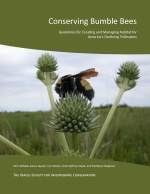 By Rich Hatfield, Sarina Jepsen, Eric Mader, Scott Hoffman Black and Matthew Shepherd Bumble bees, key pollinators of crops and wildflowers across the country and essential for a healthy environment, are declining at an alarming rate. Bee biologists discovered that several previously common species are now absent from much of their former territory. Creating, protecting and restoring habitat is a very important way to conserve the populations of bees that remain. To help landowners and managers achieve this, the Xerces Society for Invertebrate Conservation has just released Conserving Bumble Bees. Guidelines for Creating and Managing Habitat for America’s Declining Pollinators.
“These guidelines provide the information that land managers need, along with a set of straightforward strategies to guide the creation and management of good quality bumble bee habitat,” said Rich Hatfield, lead author and Xerces Society Conservation Associate. “By following these practices we can help to slow, stop, or potentially reverse recent population trends and help to maintain bumble bees as a productive part of our environment.”
The causes of these declines are not fully understood, but likely playing a role are: loss or fragmentation of habitat, pesticide use, overgrazing, competition with honey bees, climate change, low genetic diversity, and perhaps most significant of all, the introduction of nonnative pathogens.
Regardless of the ultimate cause of bumble bee declines, surviving populations need high quality habitat to persist. Protecting, restoring, enhancing, and creating new bumble bee habitat is the best way to conserve populations of these indispensable animals and hopefully reverse population trends. Conserving Bumble Bees includes sections on the important role these animals play in both agricultural and wild plant pollination, details the threats they face, and provides information on creating, restoring, and managing high quality habitat. Importantly, these guidelines also describe how land managers can alter current practices to be more in sync with the needs and lifecycle of bumble bees. They also include regional bumble bee identification guides and lists of important bumble bee plants by region.
“We hope that these guidelines will inspire people to take action, whether it is in a natural area, an urban yard, a suburban greenspace, or on a farm, or natural area,” said Sarina Jepsen report co-author and Xerces’ Endangered Species Program Director.
See Attached files here:
|
